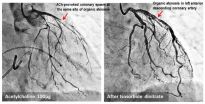(Press-News.org) A 'gene signature' that could be used to predict the onset of diseases, such as Alzheimer's, years in advance has been developed in research published in the open access journal Genome Biology.
The study aimed to define a set of genes associated with 'healthy ageing' in 65 year olds. Such a molecular profile could be useful for distinguishing people at earlier risk of age-related diseases. This could improve upon the use of chronological age and complement traditional indicators of disease, such as blood pressure.
Lead author James Timmons, from King's College London, UK, said: "We use birth year, or chronological age, to judge everything from insurance premiums to whether you get a medical procedure or not. Most people accept that all 60 year olds are not the same, but there has been no reliable test for underlying 'biological age'.
"Our discovery provides the first robust molecular 'signature' of biological age in humans and should be able to transform the way that 'age' is used to make medical decisions. This includes identifying those more likely to be at risk of Alzheimer's, as catching those at 'early' risk is key to evaluating potential treatments."
The researchers analyzed the RNA of healthy 65 year old subjects, and used the information to develop a signature of 150 RNA genes that indicated 'healthy ageing'. The signature was found to be a reliable predictor for risk of age-related disease when studying RNA from tissues including human muscle, brain and skin.
With this RNA signature, they developed a 'healthy age gene score' which they used to test and compare the RNA profiles of different individuals, and demonstrated that a greater score was associated with better health in men and women.
The researchers studied RNA from healthy 70 year old subjects and analyzed follow-up health data over two decades. Despite all subjects being born within a year of each other, their RNA at around 70 years of age demonstrated a very wide distribution in 'healthy age gene score', varying over a four-fold range. This variation was shown to link to long term health. A greater gene score was also associated with better cognitive health and renal function across a 12 year span - both important determinants of mortality.
In particular, they demonstrated that patients diagnosed with Alzheimer's Disease had an altered 'healthy ageing' RNA signature in their blood, and therefore a lower healthy age gene score, suggesting significant association with the disease.
Timmons added: "This is the first blood test of its kind that has shown that the same set of molecules are regulated in both the blood and the brain regions associated with dementia, and it can help contribute to a dementia diagnosis. This also provides strong evidence that dementia in humans could be called a type of 'accelerated ageing' or 'failure to activate the healthy ageing program'."
Given that early intervention is important in Alzheimer's and there is a need to identify those at greatest risk, the authors say that their 'healthy age gene score' could be integrated to help decide which middle-aged subjects could be offered entry into a preventative clinical trial many years before the clinical expression of Alzheimer's.
INFORMATION:
Notes to editor:
1. Research article
A novel multi-tissue RNA diagnostic of healthy ageing relates to cognitive health status
Sanjana Sood, Iain J. Gallagher, Katie Lunnon, Eric Rullman, Aoife Keohane, Hannah Crossland, Bethan E. Phillips, Tommy Cederholm, Thomas Jensen, Luc JC van Loon, Lars Lannfelt, William E. Kraus, Philip J. Atherton, Robert Howard, Thomas Gustafsson, Angela Hodges and James A. Timmons
Genome Biology 2015
doi 10.1186/s13059-015-0750-x
After embargo, article available at journal website here: http://dx.doi.org/10.1186/s13059-015-0750-x
Please name the journal in any story you write. If you are writing for the web, please link to the article. All articles are available free of charge, according to BioMed Central's open access policy.
2. Genome Biology serves the biological research community as an international forum for the dissemination, discussion and critical review of information about all areas of biology informed by genomic research. Key objectives are to provide a guide to the rapidly developing resources and technology in genomics and its impact on biological research, to publish large datasets and extensive results that are not readily accommodated in traditional journals, and to help establish new standards and nomenclature for post-genomic biology.
3. BioMed Central is an STM (Science, Technology and Medicine) publisher which has pioneered the open access publishing model. All peer-reviewed research articles published by BioMed Central are made immediately and freely accessible online, and are licensed to allow redistribution and reuse. BioMed Central is part of Springer Science+Business Media, a leading global publisher in the STM sector. http://www.biomedcentral.com
A study led by Dr. Bing Hu at Plymouth University Peninsula Schools of Medicine and Dentistry and involving other researchers from China and Switzerland, suggests for the first time that the use of local anaesthetic may affect tooth cell growth and the development of children's teeth.
The study is published today, Monday 7th September 2015, in Cell Death Discovery, a new leading translational medical research journal from Nature Publishing Group, and comes at a time when more children than ever before are subjected to dental surgery - and local anaesthetic - because of ...
A highly effective drug that helps smokers to quit does not increase their risk of heart attack and depression as was previously thought, research suggests.
Researchers who carried out the study say doctors can prescribe varenicline - also known as Champix™ or ChantixTM - more widely to help people stop smoking.
Varenicline is the most effective medication to help smokers quit but previous reports have suggested that users may be more likely to suffer a heart attack.
The drug has also been linked to depression, self-harm and suicide.
This latest research ...
Fewer patients are admitted at weekends, but are more likely to be sicker and have a higher risk of death from Friday through until Monday
Authors caution against using the data to estimate avoidable deaths, but call for more research into how services can be improved to reduce risk
Patients admitted to hospital at the weekend are more likely to be sicker and have a higher risk of death, compared with those admitted during the week, finds an analysis published in The BMJ this week.
The analysis was carried out as a collaboration between University Hospital Birmingham ...
Action to prevent tooth decay in children, such as supervised tooth brushing and fluoride varnish schemes, are not just beneficial to children's oral health but could also result in cost savings to the NHS of hundreds of pounds per child, so says a leading dental health researcher.
Professor Elizabeth Kay, Foundation Dean of the Peninsula Dental School from Plymouth University Peninsula Schools of Medicine and Dentistry, has carried out the first economic evaluation of public health measures to reduce tooth decay in children at high risk, in association with the National ...
An international team of scientists has developed what may be the first one-step process for making seamless carbon-based nanomaterials that possess superior thermal, electrical and mechanical properties in three dimensions.
The research holds potential for increased energy storage in high efficiency batteries and supercapacitors, increasing the efficiency of energy conversion in solar cells, for lightweight thermal coatings and more. The study is published today (Sept. 4) in the online journal Science Advances.
In early testing, a three-dimensional (3D) fiber-like ...
Washington, DC - September 4, 2015 - Decontamination protocols eradicated both methicillin-resistant Staphylococcus aureus (MRSA) and antibiotic resistant, pathogenic intestinal bacteria, the Enterobacteriaceae, from a pig farm. The research appears online September 4th in ASM's journal Applied and Environmental Microbiology.
The study involved a farm on which both pathogens had been discovered through routine monitoring. The farmer had approached the investigators for help. The Enterobacteriaceae were expressing resistance genes called extended-spectrum β-lactamases ...
WINSTON-SALEM, N.C. - Sept. 4, 2015 - A commonly prescribed antidepressant may alter brain structures in depressed and non-depressed individuals in very different ways, according to new research at Wake Forest Baptist Medical Center.
The study - conducted in nonhuman primates with brain structures and functions similar to those of humans - found that the antidepressant sertraline, a selective serotonin reuptake inhibitor (SSRI) marketed as Zoloft, significantly increased the volume of one brain region in depressed subjects but decreased the volume of two brain areas in ...
Far above the wildfires raging in Washington's forests, a less noticeable consequence of this dry year is taking place in mountain ponds. The minimal snowpack and long summer drought that have left the Pacific Northwest lowlands parched also affect the region's amphibians due to loss of mountain pond habitat.
According to a new paper published Sept. 2 in the open-access journal PLOS ONE, this summer's severe conditions may be the new normal within just a few decades.
"This year is an analog for the 2070s in terms of the conditions of the ponds in response to climate," ...
The misery of motion sickness could be ended within five to ten years thanks to a new treatment being developed by scientists.
The cause of motion sickness is still a mystery but a popular theory among scientists says it is to do with confusing messages received by our brains from both our ears and eyes, when we are moving.
It is a very common complaint and has the potential to affect all of us, meaning we get a bit queasy on boats or rollercoasters. However, around three in ten people experience hard-to-bear motion sickness symptoms, such as dizziness, severe nausea, ...
This news release is available in Japanese.
Researchers at Kumamoto University in Japan have found that patients with coronary spasm have a higher risk of experiencing future heart attack particularly when a spasm occurs at the site of atherosclerotic coronary artery narrowing, i.e., coronary atherosclerotic stenosis.
Angina is caused by the narrowing of the blood vessels that carry blood to the heart, and vasospastic angina patients account for about 40% of all angina patients. The incidence and progression of the disease can be reduced through appropriate drug treatment ...


